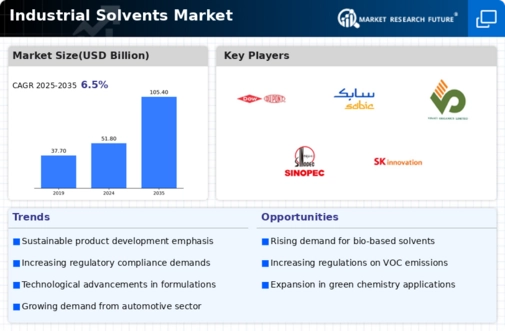Market Analysis
In-depth Analysis of Industrial Solvents Market Industry Landscape
The industrial solvents market is driven by several key dynamics that shape its growth and development. One of the primary factors influencing market dynamics is the demand from various industries such as pharmaceuticals, paints and coatings, adhesives, and chemical manufacturing. These industries rely heavily on solvents for processes such as cleaning, dissolving, and diluting substances, making solvents an essential component of their operations.
Solvents find wide use in the manufacturing of paints & coatings, the US is one of the key manufacturers of paints & coatings globally, which is contributing to the growth of the regional market.
Additionally, regulatory policies and environmental concerns play a significant role in shaping market dynamics. Governments around the world are increasingly implementing stringent regulations aimed at reducing emissions of volatile organic compounds (VOCs) and other harmful chemicals associated with solvent use. As a result, there is growing demand for environmentally friendly solvents that have lower VOC emissions and pose fewer risks to human health and the environment.
Another key factor influencing market dynamics is the availability and cost of raw materials used in solvent production. Solvents can be derived from a variety of sources, including petroleum, natural gas, and renewable resources such as bio-based materials. Fluctuations in the prices of these raw materials can impact the overall cost of solvent production, which in turn affects market dynamics and pricing strategies employed by manufacturers.
Furthermore, technological advancements and innovation play a crucial role in driving market dynamics within the industrial solvents industry. Manufacturers are constantly seeking to develop new and improved solvent formulations that offer enhanced performance, safety, and environmental sustainability. This includes the development of alternative solvents with lower toxicity and higher biodegradability, as well as the use of novel processing techniques to improve efficiency and reduce waste.
Market dynamics are also influenced by factors such as supply chain disruptions, geopolitical tensions, and macroeconomic trends. For example, disruptions in the supply of raw materials or transportation infrastructure can lead to shortages and price volatility within the market. Similarly, shifts in global trade patterns or changes in consumer preferences can impact the demand for certain types of solvents and drive changes in market dynamics.
In recent years, there has been a growing trend towards the adoption of green solvents and sustainable practices within the industrial solvents market. This trend is driven by increasing awareness of environmental issues and the need for businesses to reduce their carbon footprint. As a result, manufacturers are investing in research and development to create solvents that are derived from renewable resources, have minimal impact on the environment, and meet the stringent regulatory requirements imposed by government agencies.
Overall, the industrial solvents market is influenced by a complex interplay of factors including demand from various industries, regulatory policies, raw material availability, technological advancements, and macroeconomic trends. As the industry continues to evolve, companies will need to adapt to these changing dynamics by innovating new products, improving sustainability practices, and staying abreast of emerging trends in order to remain competitive in the global marketplace.








Leave a Comment